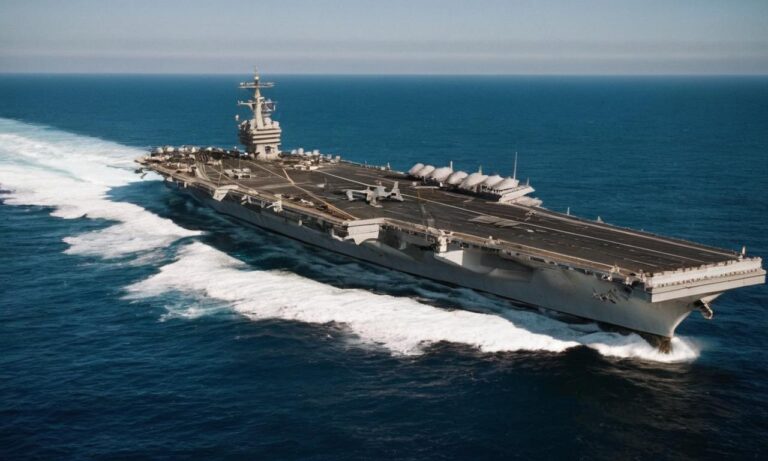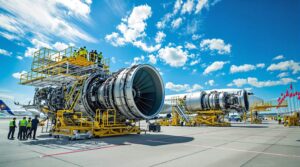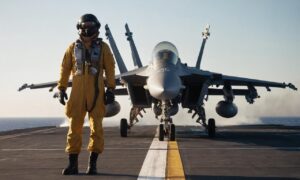When it comes to military power projection on the high seas, few vessels embody strength and capability like aircraft carriers. These colossal ships are the backbone of modern naval fleets, serving as mobile airbases capable of deploying and sustaining a wide array of aircraft. Let’s delve into the dimensions and sheer size of these engineering marvels that dominate the world’s oceans.
The Scale of an Aircraft Carrier
Measuring the size of an aircraft carrier involves considering various dimensions, with length, width, and displacement being key factors. The Nimitz-class carriers, for instance, are among the largest and most well-known types, with a length exceeding 1,000 feet (approximately 305 meters) and a width of around 134 feet (about 40.8 meters). These floating giants displace over 100,000 tons of water when fully loaded with aircraft, crew, and supplies.
Flight Deck Dimensions
The most prominent feature of an aircraft carrier is its expansive flight deck, where aircraft take off and land. The flight deck of a Nimitz-class carrier, for example, spans about 4.5 acres, providing ample space for various aircraft operations. This vast deck is meticulously designed to accommodate different types of aircraft, from fighter jets to reconnaissance planes and helicopters.
Comparisons and Historical Context
Understanding the magnitude of aircraft carriers becomes even more apparent when comparing them to other naval vessels. A typical cruiser or destroyer, for instance, is dwarfed in size and capability by these floating airbases. The historical evolution of aircraft carriers reflects a continuous effort to build larger and more versatile vessels to meet the evolving needs of modern naval warfare.
Global Fleet of Aircraft Carriers
Today, several nations operate aircraft carriers, each with its unique design and specifications. The United States Navy, with its Nimitz-class and Ford-class carriers, boasts some of the largest and most advanced carriers in the world. Other nations, such as China, the United Kingdom, and India, also contribute to the global fleet of aircraft carriers, each with its own impressive capabilities and size.
Technological Advancements
Advancements in technology continue to influence the size and capabilities of aircraft carriers. The latest Ford-class carriers, for instance, incorporate cutting-edge features like electromagnetic aircraft launch systems (EMALS) and advanced arresting gear (AAG), enhancing the efficiency and effectiveness of aircraft operations on board.
Strategic Importance
The size of an aircraft carrier directly correlates with its strategic importance on the battlefield. These floating airbases serve as force multipliers, projecting power across vast distances and providing a mobile platform for air superiority. The ability to carry a diverse range of aircraft, along with the sheer size and presence of these carriers, makes them indispensable assets in modern naval warfare.
In conclusion, the question “how large is an aircraft carrier” goes beyond mere dimensions; it encompasses the strategic significance, historical context, and technological advancements that define these colossal vessels. As nations continue to invest in naval capabilities, the size of aircraft carriers will likely evolve, ensuring their continued dominance on the world’s oceans.
Frequently Asked Questions
Curious minds often seek more information about aircraft carriers. Here are some frequently asked questions that provide additional insights into these impressive naval vessels:
- What is the average crew size of an aircraft carrier?
- How long does it take to build an aircraft carrier?
- What types of aircraft are deployed on aircraft carriers?
The crew size of an aircraft carrier varies, but it typically ranges from 3,000 to 5,000 personnel. This includes not only the flight and maintenance crews but also various support staff and officers.
The construction time for an aircraft carrier depends on its class and complexity. Generally, it can take several years to complete an aircraft carrier, with the most advanced classes requiring a longer construction period.
Aircraft carriers are designed to accommodate a diverse range of aircraft, including fighter jets, reconnaissance planes, helicopters, and electronic warfare aircraft. The flexibility to deploy different types of aircraft enhances the carrier’s versatility in various military operations.
Environmental Impact
Beyond their military significance, aircraft carriers also raise questions about their environmental impact. The construction, operation, and eventual decommissioning of these massive vessels have implications for marine ecosystems and natural resources.
| Aspect | Environmental Impact |
|---|---|
| Construction | The construction process involves significant energy consumption, raw material usage, and emissions. Shipyards must adhere to environmental regulations to mitigate these impacts. |
| Operation | Aircraft carrier operations contribute to fuel consumption and emissions. Ongoing research focuses on developing more sustainable propulsion technologies for naval vessels. |
| Decommissioning | The decommissioning of aircraft carriers raises challenges in recycling materials and managing hazardous substances. Environmental considerations play a crucial role in the disposal process. |
Future Trends and Innovations
Looking ahead, the future of aircraft carriers involves continuous innovation and adaptation to emerging challenges. Several trends and advancements shape the trajectory of these naval behemoths:
- Unmanned Aerial Vehicles (UAVs)
- Electromagnetic Propulsion
- Modular Design
The integration of UAVs on aircraft carriers is a growing trend, offering new possibilities for reconnaissance, surveillance, and strategic capabilities without risking human lives.
Ongoing research explores electromagnetic propulsion systems as a potential alternative to traditional steam catapults, aiming to enhance efficiency and reduce the environmental footprint of carrier operations.
Future aircraft carriers may feature modular designs, allowing for easier upgrades and adaptations to accommodate evolving technologies and mission requirements.






